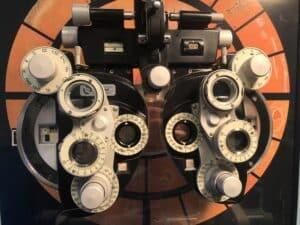 What are some ways to determine if you need a new glasses prescription?
What are some ways to determine if you need a new glasses prescription?
This is a frequent question and a good one. How do you determine if you need a new glasses prescription – or if your current glasses prescription is wrong? It can be hard to tell when things have changed enough to warrant new lenses. Typically, changes in glasses prescriptions are very gradual, meaning that every day looks about like the day before.
One good way to tell if you need new glasses is this: Ask yourself if you are having difficulty seeing what you need to see. This sounds simple, but we actually see at three different distances, and you may not have issues seeing at every distance. The three distances are distant (far away….for driving, movies, etc.), intermediate, which is where conversations happen and where your computer monitor is, and near, which is where our phone, books, and magazines are viewed.
Even with knowledge of these different viewing distances in mind, it can be hard to tell when it’s time for a new glasses prescription. This is largely because the typical reasons for a change in your glasses prescription result in slow, gradual changes. As a result there is not a dramatic difference from one day to the next.
It’s noteworthy that a sudden loss of vision in one or both eyes could be indicative of a serious medical problem. If this occurs, do not pass go. Go directly to your local eye doctor and ask for a comprehensive eye exam with dilation. If you think it’s a medical emergency and your eye clinic is closed, you should present to the emergency department at your local hospital. In Seattle we steer patients to the UW Medical Center in Montlake or Harborview hospital in central Seattle.
What are some behavioral and/or physical signs that may indicate your child needs glasses?
The majority of kids have normal development and see pretty well by age 4 or 5. If you notice an eye turn (crossed eyes or a wandering eye) or your child seems to need to sit too close to what they want to see (the TV, etc.), they may have early vision issues. Kids age five and under should see a pediatric optometrist. In many towns and cities, doctors who are members of the American Optometric Association offer FREE pediatric eye exams for kids age 6 months to 12-months. This exam is a detailed health screening for babies that can detect developmental issues and large prescriptions, both of which can have serious implications for future ocular health. When caught early, these issues can be much less impactful.
Another thing to keep in mind is that kids don’t typically know if there’s an issue, as they assume everybody else’s vision is similar to theirs. Yet undetected (or uncorrected) refractive error can cause real academic challenges. Some students that are smart enough to be in honors classes end up struggling in school simply because they can’t see the board or their books well enough. Go ahead and get your child an eye exam. It could improve their life dramatically.
A really good benchmark is to get your kids an annual eye exam with an optometrist from age 5 (kindergarten) until they graduate college. This helps to catch any health issues early, and will reduce the odds that your kid will find school frustrating and challenging.
Cannon EyeCare in Seattle is not a pediatric specialty clinic, but we love working with kids. Our optometrists start seeing kids when they know their letters and can sit in a chair and answer basic questions. Typically this is about age five.
